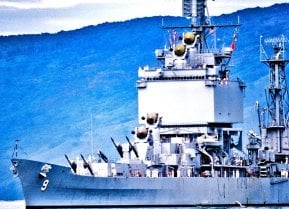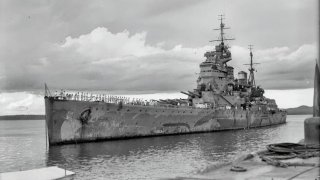The Sinking of HMS Prince of Wales Meant the Battleship Era Was Over
The sinking of the HMS Prince of Wales by Imperial Japan in the South China Sea in December 1941 marked a significant turning point in World War II, illustrating the power of aerial warfare over traditional battleship dominance.
Summary: The sinking of the HMS Prince of Wales by Imperial Japan in the South China Sea in December 1941 marked a significant turning point in World War II, illustrating the power of aerial warfare over traditional battleship dominance. Part of Force Z, alongside HMS Repulse and initially intended to include the aircraft carrier HMS Indomitable, the Prince of Wales was deployed to deter Japanese expansion. However, the absence of air cover, due to the Indomitable's grounding and the heavy losses at Pearl Harbor, left the battleship vulnerable. Japanese Admiral Isoroku Yamamoto capitalized on this by deploying bombers trained in low-altitude torpedo attacks, resulting in the sinking of both the Prince of Wales and the Repulse.
The Downfall of HMS Prince of Wales: A Shift in Naval Warfare
The sinking of the HMS Prince of Wales by Imperial Japan was a pivotal moment in the Second World War.
The Western Allies suffered this debilitating blow in the South China Sea just days after the Pearl Harbor attack in 1941. On the occasion, the Japanese demonstrated the effectiveness of aerial attacks against battleships. The sinking of both the HMS Prince of Wales and the battlecruiser HMS Repulse was a turning point for aircraft carriers and carrier-based warfare. It highlighted the diminishing dominance of the battleship.
The Story
On December 10, 1941, the Allies were still reeling from the staggering Pearl Harbor attacks. The Repulse and Prince of Wales were deployed to the Far East as part of Force Z, a naval squadron tasked with deterring Imperial Japan’s territorial expansion.
The Illustrious-class aircraft carrier HMS Indomitable was initially included in this task force for air cover, but it ran aground in the Caribbean Sea prior to the mission.
When British Prime Minister Winston Churchill publicly declared that Force Z was sailing toward Singapore, Japanese Adm. Isoroku Yamamoto sent reinforcements. Thirty-six Mitsubishi G4M bombers were deployed to assist the Mitsubishi G3M-equipped Kanoya and Genzan Air Groups already at sea. Bombers on these boats were specially trained for ship killing operations, able to launch torpedo attacks at altitudes of less than 10 meters.
Prior to Pearl Harbor, the U.S. Pacific Fleet had explored the option of sending reinforcements to aid the British when the war broke out. But with eight U.S. battleships sunk, this was no longer a viable plan.
The commander of Force Z, Adm. Sir Tom Philips, decided to proceed in an offensive role in order to thwart Japan’s overrun of Malaya. Philips likely underestimated Japan’s capabilities, and he did not believe that an air attack could prove fatal to his ships.
Even after the attack progressed, Phillips failed to request air cover on the radio. In fact, the Royal Air Force learned of the attack when the commander of the Repulse called in the incident about an hour after the strikes commenced. The Japanese achieved eight torpedo hits out of 49, with four striking both the Prince of Wales and the Repulse.
Introducing Battleship Prince of Wales
The Prince of Wales entered service with the British Navy in early 1941 as the third ship in the King George V battleship class. Able to displace 35,000 tons, the hefty ship was quite formidable. She could sail at speeds in excess of 28 knots and was heavily armed. 10 BL 14-inch Mk VII guns were mounted onto the Prince of Wales, in addition to 16 QF 5.25inch Mk 1 guns. She also was equipped with short-range rocket-firing anti-aircraft weapons.
While still in drydock in 1940, the Prince of Wales suffered a bomb hit from a German aircraft. The UK then quickly introduced the battleship to service, reacting to the growing threat of Germany’s own battleships, the Bismarck and Tirpitz.
Despite the Prince of Wales' untimely 1941 sinking, she served extensively in the early days of the war and is considered a legendary battleship.
About the Author: Maya Carlin
Maya Carlin, National Security Writer with The National Interest, is an analyst with the Center for Security Policy and a former Anna Sobol Levy Fellow at IDC Herzliya in Israel. She has by-lines in many publications, including The National Interest, Jerusalem Post, and Times of Israel. You can follow her on Twitter: @MayaCarlin. Email the author: [email protected].


